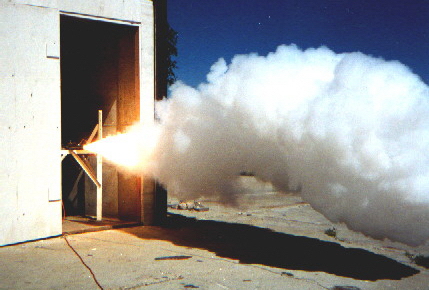Martian Rocket Propellant - Carbon Dioxide & Magnesium

Initial Combustion Tests Show The Way
The further exploration of Mars by robotic and manned missions will require a propellant taking advantage of what is available on Mars. Under NASA funding, Wickman Spacecraft & Propulsion Company (WSPC) started developing a new rocket engine and turbojet engine for use on Mars taking full advantage of the Martian atmosphere – carbon dioxide. Prior to this, most researchers focused on converting carbon dioxide to carbon monoxide to burn with oxygen or converting carbon dioxide to methane. The first option requires energy to break down the carbon dioxide and the second requires that hydrogen be brought to Mars. WSPC looked at the possibility of burning the carbon dioxide directly. This would open up the possibility of Martian “air breathing” engines like jet engines. An option that is not possible with the carbon monoxide or methane approach.
While carbon dioxide is a common fire extinguishing agent, it burns very well with magnesium powder. While other investigators focused on single particle or very small quantities of magnesium combustion with carbon dioxide, Wickman plunged in with burning magnesium powder in large quantities in burners, rocket engines and jet engines. After testing many methods of burning magnesium with carbon dioxide, Wickman discovered a simple way of fluidizing the magnesium powder with kerosene and then burning it with carbon dioxide gas. The video shows the very first time this approach was successful. The coating of kerosene on the magnesium powder proved to be a problem in igniting the magnesium powder. Later research indicated that a better way to inject the magnesium powder into the combustion chamber was to use a inert carrier gas like nitrogen. The first open air test of a carbon dioxide and magnesium powder combustion chamber.
Making A Mars Rocket Engine Work
In 1997, Wickman Spacecraft & Propulsion Company made a technological breakthrough by firing the first rocket engine which used carbon dioxide as the oxidizer and magnesium powder as the fuel. The engine produced an average thrust of 40 lbs. The test engine was fired repeatedly as part of the NASA program to develop this revolutionary technology for future Mars Rovers and Mars Sample Return Missions.
As part of this program, WSPC also developed a small one pound thruster that could be used for steering or attitude control on a flying rover. As part of the final test, the thruster was cycled on and off by controlling the flow of magnesium powder to it while keeping the carbon dioxide flow constant. The test was successful with the thruster going on and off with the flow of the magnesium powder.
This technology is now ready for the next step, which is the design of a rocket engine using the Mars atmosphere directly to power the first stage of a Mars sample return or other mission. The jet engine is ready for further development for eventual use on a Mars airplane.